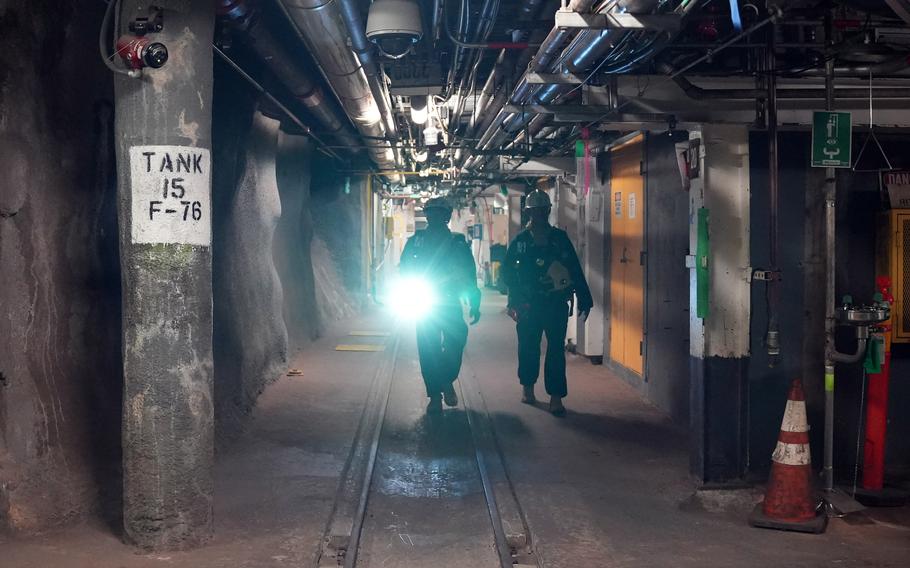
Security and fire watch team members patrol the Red Hill Bulk Fuel Storage Facility in Halawa, Hawaii, Sep. 6, 2023. (Nicholas Brown/Department of Defense)
(Tribune News Service) — The Halawa Shaft, one of Oahu’s major sources of fresh drinking water, was permanently shut down following massive leaks of jet fuel at the Navy’s Red Hill Bulk Fuel Storage in 2021. Now the state Department of Health, in partnership with the U.S. Environmental Protection Agency, says it could offer up to $75 million to the city to reopen that crucial water source.
The DOH sent Board of Water Supply Manager and Chief Engineer Ernest Lau a letter on Wednesday with information on tapping into the $400 billion Bipartisan Infrastructure Law.
Enacted under the Biden administration to fund infrastructure projects nationwide, the federal law also addresses “emerging contaminants“ as well as perfluoroalkyl and polyfluoroalkyl substances, or PFAS—sometimes called “forever chemicals“ — which do not break down in the environment and pose health risks to humans and animals.
“A project is eligible for this funding if it addresses any contaminant that does not currently have a set Federal Maximum Contaminant Level and appears on any of the Drinking Water Contaminant Candidate List,“ the DOH letter reads. “The BILEC funds are provided through 2026 and are 100% grant or principal forgiveness.”
The letter says that “if test results show that the water from Halawa Shaft is not currently safe to drink, the federal funds can be used for a treatment system that will enable BWS to bring the Halawa Shaft back into service, adding a resource of 10 million gallons per day.”
Since the DOH announcement, the water agency says it needs more information about the offer.
“We need to meet with DOH to learn more about the program and the $75 million, before we can effectively comment,“ BWS spokesperson Kathleen Elliott -Pahinui told the Honolulu Star-Advertiser on Monday afternoon.
Meantime, Gov. Josh Green weighed in on the matter, noting that in late November the BWS board of directors formally raised water rate fees to the public for the next 5 1/2 years.
“The BWS’ decision to raise water rates by about 50% may create a hardship for many residents. It’s important for the BWS to take advantage of available federal funding to reduce the costs it passes on to Oahu residents,“ Green said in a written statement. “My administration is focused on partnerships and solutions, and I appreciate DOH’s efforts to secure this federal funding opportunity.”
Others, like DOH Director Kenneth Fink, said using federal money to restart Halawa Shaft would be a wise move.
“While DOH monitors the Navy’s aquifer remediation efforts, these federal funds provide an opportunity to increase the supply of safe drinking water in the near term and potentially avoid the need to construct a new replacement well,“ Fink said in a written statement. “Similar treatment systems have already been installed in Mililani and at the Ewa Shaft treatment facility to provide safe drinking water to Oahu residents.”
In addition, the DOH letter outlines other city projects that could qualify for federal funding.
“Between 2006 to 2016, DOH disbursed $12, 096, 983.25 to construct a granular activated carbon treatment (GAC ) facility with 24 GAC contactors for the Ewa Shaft sources,“ the DOH letter reads. “It is our understanding that the facility was never brought online since its construction.”
DOH notes federal funds “may be used to update the rusting Ewa Shaft treatment facility to address qualifying contaminants of concern at this source. This would add 13 (million gallons per day) to Ewa and Metropolitan Honolulu communities.”
Other projects could include PFAS detection in the Kaamilo, Waipahu, Waipio Heights, Halawa and Moanalua wells, DOH says.
“EPA will be releasing the final (maximum contaminant level) for PFAS in the very near future. Some of these sources have existing GAC contactors and short chain PFAS compounds have passed through the treatment,“ the DOH letter reads.
BWS, it adds, can use these funds “to install or upgrade water treatment to remove a broad spectrum of PFAS compounds currently pending regulation and those that may be regulated in the future.”
Meanwhile, since the 2021 Red Hill fuel leaks, BWS Manager Lau has stated strong reluctance to ever reopening Halawa Shaft. He’s noted that closure of the source, which supplied fresh drinking water from Halawa Valley to Hawaii Kai, was done to reassure the public that Oahu’s drinking water was safe.
However, not reopening Halawa Shaft means the city will need to spend tens of millions of dollars replacing lost water production, including finding a new water shaft among other alternate water well projects, BWS says.
“We took the precautionary step to shut down Halawa Shaft because of what we saw happening to the Navy’s water system and their water source just across the valley from us,“ Lau told the City Council’s Committee on Housing, Sustainability and Health on Nov. 28.
(c)2023 The Honolulu Star-Advertiser
Visit www.staradvertiser.com
Distributed by Tribune Content Agency, LLC.